Blogs
How do I open a DEMAT account in Nepal?
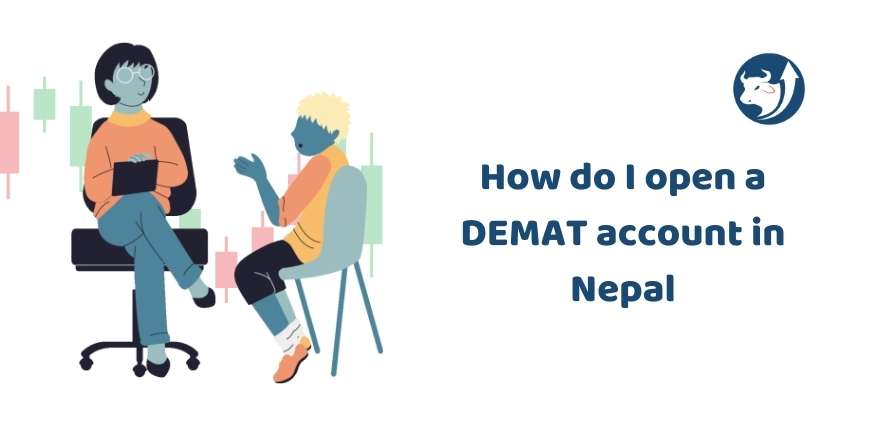
What is a DEMAT account?
A DEMAT account is an account that holds your securities like stocks, bonds, mutual funds, etc., in electronic form, just like a bank account holds your money. In short, DEMAT is the process of dematerializing physical documents into electronic form. Earlier, the market operated traditionally, where securities were issued in paper form, and investors had to hold and transfer these paper certificates physically.
Since all securities are stored in DEMAT, it has become mandatory for share traders. It has made trading faster, simplified processes, reduced paperwork, and minimized the risks of document loss and damage associated with physical certificates.
Documents required
The cost of opening a DEMAT account ranges from Rs. 50 to Rs. 150. It needs to be renewed annually, with renewal charges of up to Rs. 100 per year.
Documents required
- Citizenship Certificate of the investor (including details of three generations)
- Recent passport-size photo
- Bank Details
In the case of minors, parents/guardians should submit
- Photo of the account holder
- Birth certificate
- Copy of the parents/guardian’s citizenship
How to open a DEMAT Account in Nepal?
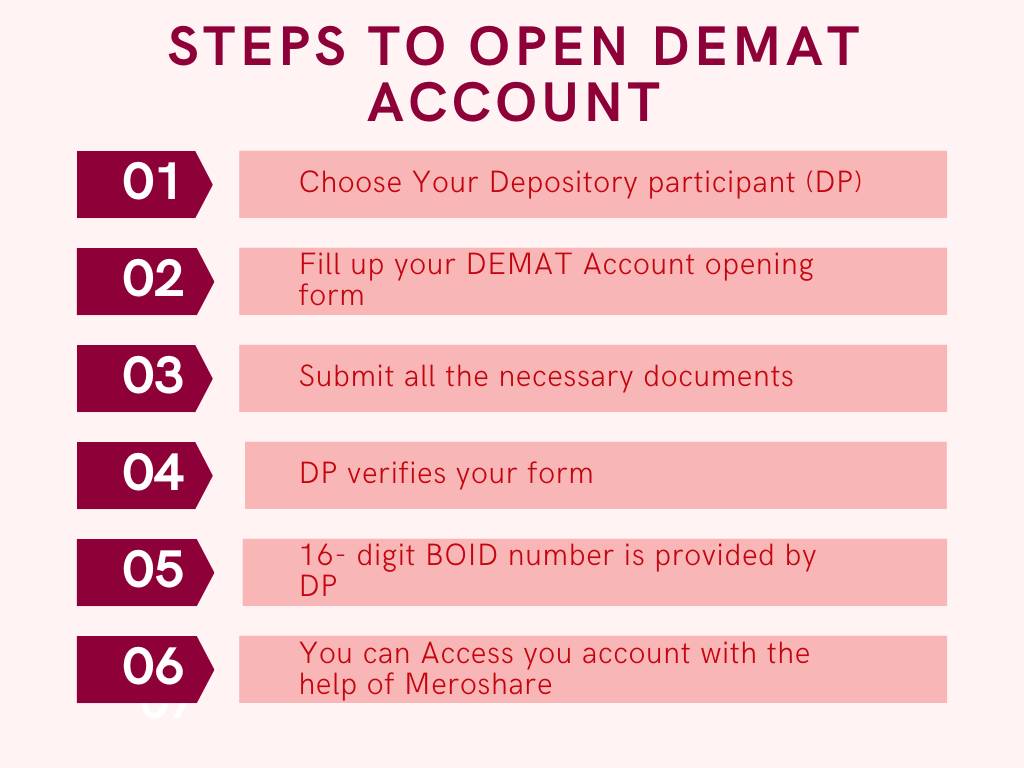
Steps to Open a Demat Account
You can open your demat account online or by visiting the bank physically. The process of opening a demat account is very similar to the bank account opening process.
Follow the below steps to open a DEMAT account:
Step 1: Visit a particular bank’s website, where you can find a form to enter your details.
Step 2: After submitting the form, the information is reviewed and entered by the Depository participant (DP) into the system of CDSC.
Step 3: CDSC verifies the form and opens the demat account for the beneficiary.
Step 4: Then CDSC writes a verification letter to the beneficiary providing the 16-digit demat account number. (8-digit DP Identification Number, 8-digit Client Identification Number)
After that, your account will be active and the shares you have issued or bought will be safely stored on your account.
Benefits of Opening a DEMAT Account
Opening a Demat account offers the following benefits:
- Electronic Holding: Securities held in electronic form.
- Convenient Trading: Facilitates online trading in the stock market.
- Quick Settlement: Faster and smoother settlement of transactions.
- Safety and Security: Eliminates risks associated with physical certificates.
- Portfolio Management: Provides a consolidated view of an investor’s holdings.
- Dividend and Interest Crediting: Automatic crediting of income from securities.
- Accessibility: Can be accessed from anywhere with an internet connection.
- Reduction in Paperwork: Minimizes paperwork associated with trading.
- Multiple Asset Classes: Can hold various types of securities.
- Loan Against Securities: Some investors can use holdings as collateral for loans.
FAQs
[saswp_tiny_multiple_faq headline-0=”h4″ question-0=”What is the charge for opening a Demat account?” answer-0=”The cost of opening a DEMAT account is Rs. 50 and Rs.100 for the renewal each year. That is, when opening a DEMAT account, you have to pay Rs. 150.” image-0=”” headline-1=”h4″ question-1=”Is a DEMAT account mandatory in Nepal?” answer-1=”Opening the DEMAT account is mandatory for all share transactions in Nepal. ” image-1=”” headline-2=”h4″ question-2=”How many DEMAT accounts can I open in Nepal?” answer-2=”In Nepal, there is no limit to owning a DEMAT account, but each must be linked to a different broker. A DEMAT account is necessary for stock trading in both markets. There’s a one-account limit, but it can be transferred to two accounts simultaneously. It’s legal to have multiple DEMAT and trading accounts with different brokers, each requiring its accounts.” image-2=”” headline-3=”h4″ question-3=”How many days it will take to open a Demat account in Nepal?” answer-3=”It usually takes one business day to open and activate a DEMAT account in Nepal. You can open a DEMAT account with an authorized depository participant (DP).” image-3=”” headline-4=”h4″ question-4=”Which Demat account is free in Nepal?” answer-4=”NIBL Ace Capital has offered a free DEMAT account to promote the Nepalese government’s ‘One Nepali, One DEMAT Account’ campaign.” image-4=”” count=”5″ html=”true”]
In conclusion, the DEMAT account is the process of converting all paperwork into an online electronic form. A DEMAT account is essential in today’s world for participation in the stock market. The process of opening a DEMAT account is straightforward. It has become significantly easier and beneficial because it facilitates the storage of paperwork and documents online, enhancing security. You can follow the given steps to open a DEMAT account.

Blogs
Private Power Producers Protest ‘Take and Pay’ Provision in Budget
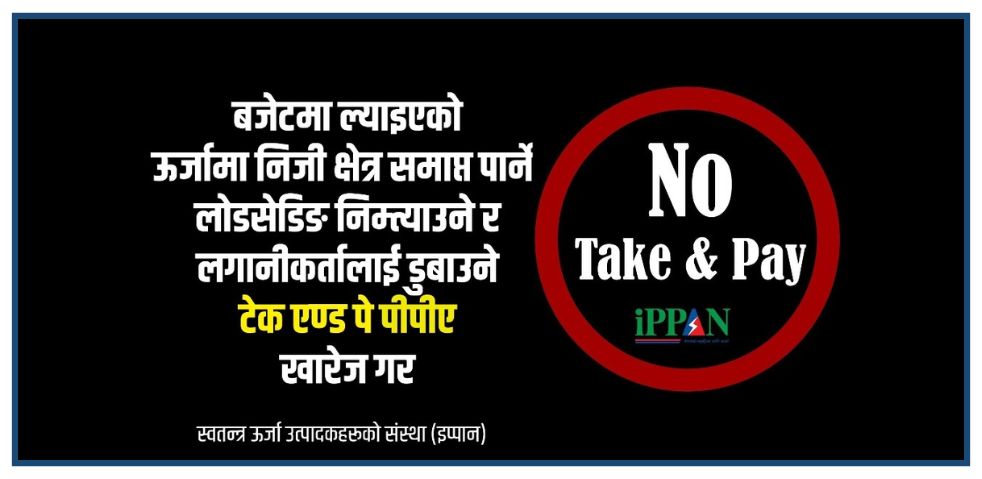
Private energy entrepreneurs in Nepal have taken to social media, protesting the government’s decision to introduce the ‘Take and Pay’ (Liu Ra Tir) system for electricity purchase agreements (PPA) in the new fiscal year budget.
Under this system, the government would only pay for the electricity it uses, instead of paying for the total electricity generated by hydropower projects. Entrepreneurs argue this move could severely hurt the private sector, discourage investment, and push the country back toward power shortages.
Online Campaign Targets Top Officials
Energy producers are now directly appealing to key government figures. They have publicly tagged Prime Minister Pushpa Kamal Dahal, Finance Minister Barshaman Pun, Energy Minister Shakti Bahadur Basnet, and NEA Executive Director Kulman Ghising on social media, urging them to withdraw the Take and Pay provision.
This digital campaign comes just days after developers handed over a memorandum to the Prime Minister and bombarded top officials with hundreds of SMS messages requesting the same.
Why Are Entrepreneurs Worried?
Entrepreneurs claim that this decision will:
- Weaken the private sector’s role in the energy industry
- Risk the return of load-shedding (power cuts)
- Causes financial losses to investors
- Damage the overall economy
The Independent Power Producers’ Association of Nepal (IPPAN) has strongly opposed the provision. According to IPPAN’s Vice President and protest coordinator Mohan Kumar Dangi, the policy shift will discourage private hydropower development, especially for Run-of-River (RoR) projects, which are most affected by the new model.
Ongoing Protests and Next Steps
Since Asar 6, private power developers have been staging a phase-wise protest. On the third day of their movement, they moved their campaign to social media to raise public awareness and pressure the government.
Dangi warned that if the government ignores these peaceful efforts, the protests will escalate. Planned steps include:
- Lobbying political party leaders in Parliament
- Launching a nationwide street protest
- Returning the keys of privately built hydropower projects to the government — a symbolic act of handing over control
Background: The Budget Controversy
The controversy started when the budget for FY 2082/83 (announced on Jestha 15) stated that all future PPAs for RoR hydropower projects would be done under the Take and Pay model only. This was a major change from the previous Take or Pay model, where producers were paid even if electricity wasn’t consumed, offering more security for private investors.
Conclusion
The ‘Take and Pay’ decision has sparked serious concerns across Nepal’s private energy sector. Developers fear this could lead to a slowdown in future hydropower investments, and possibly, a return to unstable electricity supply. With pressure mounting both online and offline, the government’s next move will be critical for the future of Nepal’s energy landscape.
Blogs
Nepal Rastra Bank to Withdraw NPR 60 Billion from the Banking System on Monday
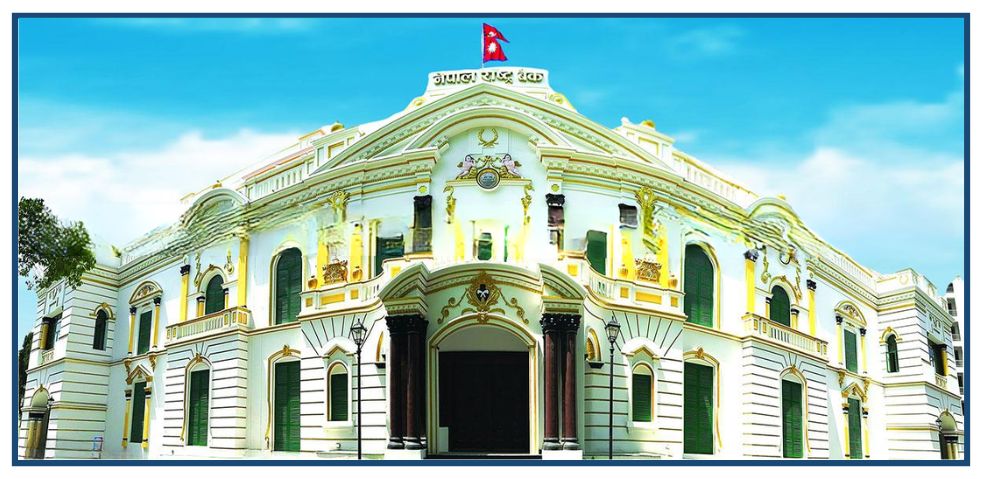
Nepal Rastra Bank (NRB), the central bank of Nepal, has announced it will withdraw NPR 60 billion in deposits from the banking system on Monday through a deposit collection auction. This move comes as excess liquidity continues to remain in the banking sector since the beginning of the current fiscal year 2081/82.
According to NRB, the withdrawal will be conducted through the online bidding system, and the interest rate will be determined through competitive bidding. The collected amount, including both principal and interest, will be settled on Shrawan 18, 2082 (August 2, 2025).
Key Auction Details
- Total Amount: NPR 60 billion
- Minimum Bid Amount: NPR 100 million
- Bid Increments: Must be divisible by NPR 50 million
- Eligible Participants: Class ‘A’, ‘B’, and ‘C’ licensed banks and financial institutions
- Auction Method: Competitive bidding via NRB’s online platform
- Maturity & Settlement Date: Shrawan 18, 2082
Why Is the Central Bank Taking This Step?
As per NRB, the banking system is currently holding excessive liquidity, with total deposits crossing NPR 7 trillion. However, this liquidity is not being effectively utilized, as loan disbursement has remained slow. This reflects a lack of investor confidence and limited credit demand in the economy.
To control liquidity and stabilize the financial market, NRB has been consistently withdrawing funds using monetary tools since the start of the fiscal year. Tools like reverse repo, outright sale, deposit collection, and bond issuance are being used depending on the situation, whether there is too much or too little money in the system.
Recent Trends in Liquidity Control
Last week alone, NRB withdrew NPR 90 billion in a single day, highlighting the ongoing efforts to manage surplus liquidity. The central bank is using such actions not only when there is an overflow of money but also in times of shortage, to maintain balance in the financial system.
Conclusion
The decision to withdraw NPR 60 billion on Monday shows that Nepal Rastra Bank is actively managing liquidity to ensure financial stability. With a large amount of unused funds in the system, these measures are crucial to prevent inflation, reduce financial risk, and encourage more effective use of capital in the economy.
Blogs
52-Week Low & High Microfinance Shares in Nepal: Current Status and Future Outlook

The microfinance sector in Nepal has been moving sideways for a long time. The group sub-index has been fluctuating between 4,600 and 5,600. Recently, the index reached a swing high of nearly 4,900 but then closed at 4,671.74.
The national budget did not bring any immediate changes that could affect the capital market. So, investors are now waiting for the upcoming monetary policy. After the newly appointed Governor of Nepal Rastra Bank, Dr. Bishwanath Paudel, reduced the risk weight on margin loans from 125% to 100% during the third quarterly review, investor confidence grew.
Investors now hope that the following changes will be introduced in the next monetary policy:
- Removal of the current Rs. 15 crore limit on individual investment
- Removal of the 15% dividend cap on microfinance institutions
- Permission for banks and financial institutions to trade shares for less than one year
Governor Paudel’s public remarks have made investors hopeful that the upcoming monetary policy will be share-market friendly.
Despite the pressure on the market at the end of Ashar, investors are optimistic about a rebound afterward. Experts say microfinance and insurance stocks—whose prices have not surged yet compared to others—might offer better opportunities in the coming days.
Top 20 Microfinance Companies Nearest to 52-Week Low

Some microfinance companies are trading close to their 52-week low prices. These stocks may offer good value for long-term investors. Here are some examples:
-
Nesdo Samriddhi Microfinance had a high of Rs. 2,641 and a low of Rs. 1,540 in the past year. It is currently trading near its lowest point.
-
Sana Kisan Bikas Microfinance and Jan Utthan Community Microfinance are both trading less than 1% above their 52-week lows.
-
Jeevan Bikas, NIC Asia, Infinity, Suryodaya Womi, RSDC, Asha, and Swabalamban Microfinance are trading just 1–3% above their yearly lows.
-
Other companies like Unique Nepal, Bijaya, Forward, Nirdhan Utthan, Diprox, Mahuli, Nerude Mirmire, National, Samata Gharelu, and Laxmi Microfinance are also trading only 3–5.5% above their low points.
According to experts, these stocks could be worth watching for those looking to invest at lower prices.
Microfinance Stocks Near 52-Week High

Interestingly, a few companies are still trading near their 52-week highs even though the overall market is in a downtrend:
-
Unnati Sahakarya Microfinance reached a high of Rs. 5,276 and is now trading at around Rs. 1,804.
-
CYCL Nepal Microfinance had a high of Rs. 1,958 and is still trading at Rs. 1,615, which is relatively strong.
On the other hand, many microfinance stocks are trading 20–40% below their 52-week highs:
-
Aatmanirbhar, Mahila, Grameen Bikas, Kalika, Global IME, Chhimek, Mero Microfinance, and Abhiyan are all trading 22% to 31% below their highs.
-
NMB, First Microfinance, RSDC, Laxmi, Nirdhan Utthan, Diprox, Sana Kisan, Mithila, National, and Swabhiman are trading 34% to 44% below their 52-week highs.
These stocks may still have room to rise if the market recovers and favorable policies are introduced.
Conclusion
The microfinance sector in Nepal is at a turning point. While the market has been moving sideways, investor confidence is building, especially with hopes for a supportive monetary policy. Stocks near their 52-week lows may offer attractive entry points, while those holding near their highs show relative strength.
For both new and experienced investors, this could be a good time to study the microfinance sector closely and plan for the long term. As always, careful research and risk assessment are essential before making any investment decisions.
-

 Blogs3 days ago
Blogs3 days agoHydropower Gains 7.8% in One Month, Outperforming All Sectors
-
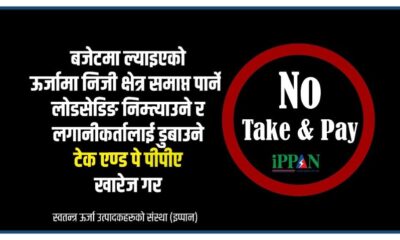
 Blogs10 hours ago
Blogs10 hours agoPrivate Power Producers Protest ‘Take and Pay’ Provision in Budget
-
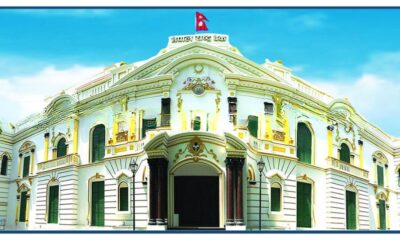
 Blogs10 hours ago
Blogs10 hours agoNepal Rastra Bank to Withdraw NPR 60 Billion from the Banking System on Monday
-

 Blogs11 hours ago
Blogs11 hours ago52-Week Low & High Microfinance Shares in Nepal: Current Status and Future Outlook
-

 Blogs1 year ago
Blogs1 year agoList of Stock Brokers in Nepal with NEPSE TMS Login – Updated
-

 Blogs12 hours ago
Blogs12 hours agoAsian Life Insurance to Issue Rights Shares from Asar 25
-

 Blogs6 months ago
Blogs6 months agoSiuri Nyadi Power Limited Added to IPO Pipeline by SEBON
-

 Blogs3 months ago
Blogs3 months agoPure Energy IPO For General Public

